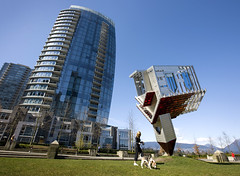Public Art, Commentary, and separation of church and state
Well, I don't know the laws of Canada, but this is still interesting. See "Artistic controversy reaches tipping point," subtitled "Vancouver's parks commissioners vote to send a sculpture of an upside-down chapel into artistic purgatory," from the Toronto Globe and Mail.

Angela Kennedy walks her dogs past Device to Root Out Evil at the foot of Bute Street in Vancouver. (Jeff Vinnick for The Globe and Mail). Go to the direct article link for a larger version of this image.
From the article:
It was too hot for New York City; too hot for Stanford University. But a controversial, imposing sculpture by renowned international artist Dennis Oppenheim finally found a public home in laid-back Vancouver. Now, after 2 1/2 years in a prominent location near Stanley Park, the upside-down country church, denounced as “blasphemous” by some aghast Christians, is about to be unceremoniously dismantled, its future uncertain.
Too many negative comments and too many neighbours complaining that the sculpture interfered with their view of scenic Coal Harbour sealed the immediate fate of Mr. Oppenheim's work, entitled Device to Root Out Evil....
And it has rekindled debate on the role of public art in a city that yearns for world-class status but often succumbs, in the eyes of critics, to small-town thinking. “The Park Board couldn't find a way to rise above the history and controversy of this sculpture,” George Wagner, an associate professor at the University of B.C. school of architecture, said Wednesday. “So they just made an expedient decision … that amounts to de facto censorship. It's quite disturbing, and makes us, in my view, a lesser city.”
Said Michaela Frosch, the disappointed chairwoman of Vancouver Sculpture Biennale, which has spearheaded an ambitious citywide program to display sculpture in public places: “I don't think we are yet prepared for this level of art. Very clearly, it does create debate and dialogue, but that's good. It helps humanize Vancouver.”
Labels: leadership-vision, public art, separation of church and state



0 Comments:
Post a Comment
<< Home